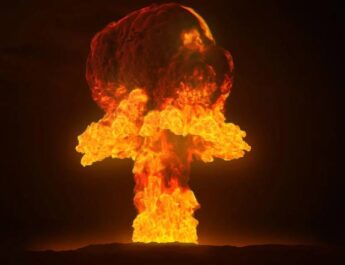Den 1 maj publicerade den US-amerikanska marxistiska tidskriften Monthly Review en artikel som beskriver de dubbla hot som mänskligheten i dag ställs inför, dels den ekologiska katastrofen, dels risken för kärnvapenkrig.
Här publicera vi de två avslutande delarna av denna artikel: The New Cold War and the European Theater och Exterminism in Two Directions:
The New Cold War and the European Theater
In “Notes on Exterminism” and his general stance as a leader of European Nuclear Disarmament in the 1980s, Thompson presented the nuclear arms buildup in Europe then occurring as the product of military machines and technological imperatives largely acting on their own. This was part of a strategy of uniting the peace movements of the West and East against their respective establishments, based on the premise that nuclear buildup was equally a product of both sides. However, in this regard, he belied his own evidence, which pointed to Washington’s aggressive nuclear buildup of counterforce weapons and the placement of strategic weapons in Europe targeting the Soviet Union. In an article on “Nuclear Chicken” in the September 1982 issue of Monthly Review, Harry Magdoff and Paul M. Sweezy challenged this part of Thompson’s argument, pointing not only to the strategic expansions of NATO under the United States, but also to the fact that the U.S. imperial order was heavily dependent on credible threats of nuclear first strikes directed at other countries, both nuclear and non-nuclear.
In a 1981 introduction to the U.S. edition of Protest and Survive edited by Thompson and Dan Cohen, Ellsberg listed a long series of documented instances where the United States used threats of nuclear first strikes, beginning in 1949, to pressure other countries to back down and achieve its imperial ends. Today, the list of such documented cases has risen to twenty-five. In this sense, the use of nuclear warfare as a threat is built into U.S. strategy. Development of nuclear primacy through counterforce weapons held out the possibility that such threats could once again be credibly directed even at major nuclear powers such as Russia and China. Magdoff and Sweezy called this whole approach a game of “nuclear chicken,” in which the United States was the most aggressive player.
Nuclear chicken did not end with the end of the Cold War. The U.S. national security state, influenced by key figures such as Zbigniew Brzezinski, Carter’s national security advisor and one of the principal architects of the post-Cold War NATO expansion, continued to seek ultimate U.S. geopolitical hegemony over Eurasia, referring to this as the “grand chessboard.” Checkmate, according to Brzezinski, would constitute bringing Ukraine into NATO as a strategic-nuclear alliance (though Brzezinski carefully excluded the nuclear aspect in presenting his geopolitical strategy), spelling the end of Russia as a great power and possibly leading to its breakup into various states. This would mark U.S. supremacy over the entire globe. This attempt to turn U.S. unipolar power after the Cold War into a permanent global empire required the expansion of NATO to the east, which commenced in 1997 during the Bill Clinton administration, gradually annexing to the Atlantic Alliance all the countries between Western Europe and Ukraine, with the latter as the ultimate prize and a dagger at Russia’s heart. Here there was a kind of oneness exhibited between the U.S.-directed strategy of NATO expansion and Washington’s drive for nuclear primacy, which preceded in almost lockstep.
The fact that Russia was compelled to consider the question of its own national security in the face of NATO’s attempt to expand militarily into Ukraine should hardly surprise anyone. A decade into the NATO expansion, which already encompassed eleven nations formerly either in the Warsaw Pact or previously part of the Soviet Union, and only a year after near U.S. nuclear primacy was highlighted in Foreign Affairs, Russian president Vladimir Putin startled the world by unequivocally declaring at the Munich Security Conference that “the unipolar world was not only unacceptable but impossible in today’s world.” Nevertheless, consistent with its long-term strategy to extend into what Brzezinski had called the “geopolitical pivot” of Eurasia, thereby fatally weakening Russia, NATO in 2008 declared outright at its Bucharest Summit that it intended to bring Ukraine into the military-strategic (nuclear) alliance.
In 2014, the Maidan coup in Ukraine, engineered by Washington, deposed the democratically elected president of Ukraine and imposed in his place a leader chosen by the White House, putting Ukraine in the hands of right-wing, ultra-nationalist forces. Russia’s response was to incorporate Crimea into its territory, after a popular referendum that gave the predominantly Russian-speaking Crimean population, who regarded themselves as independent and not part of Ukraine, a choice as to whether to remain in Ukraine or join with Russia. The coup (or “color revolution”) led to the violent repression by Kyiv of the populations in the Russian-speaking Donbass region of Ukraine, resulting in the Ukrainian Civil War between Kyiv (supported by Washington) and the breakaway Russian-speaking Donbass republics of Donetsk and Luhansk (supported by Moscow). The Ukrainian Civil War, which initially resulted in more than 14,000 deaths, continued at a low ebb over the following eight years despite the signing of the Minsk peace agreements in 2014, which were meant to end the conflict and give autonomy to the Donbass republics within Ukraine. In February 2022, Kyiv had massed 130,000 troops on the borders of Donbass in eastern Ukraine firing on Donetsk and Luhansk.
As the Ukrainian crisis worsened, Putin insisted on a number of “red lines” for Russia, referring to its essential security needs, consisting of: (1) adherence to the previous Minsk agreement (worked out by Russia, Ukraine, France, and Germany, and supported by the UN Security Council) guaranteeing the autonomy and security of Donetsk and Luhansk, (2) an end to NATO’s militarization of Ukraine, and (3) an agreement that Ukraine will remain outside NATO. All of these red lines continued to be crossed with NATO, urged on by the United States, providing increased military aid to Kyiv in its war on the Donbass republics, in what Russia interpreted as a de facto attempt to incorporate Ukraine into NATO.
On February 24, 2022, Russia intervened in the Ukrainian Civil War on the side of Donbass, attacking the military forces of the Kyiv government. On February 27, Moscow put its nuclear forces on high alert for the first time since the end of the Cold War, confronting the world with the possibility of global nuclear holocaust, this time between competing capitalist great powers. Figures in Washington, such as Senator Joe Manchin III (Democrat, West Virginia), have backed the idea of U.S. imposition of a no-fly zone in Ukraine, which would mean shooting down Russian planes, in all probability escalating into a Third World War.
Exterminism in Two Directions
It is common today to recognize that climate change represents a “global existential threat” that places in jeopardy the very survival of humanity. Today we are faced with a situation in which the continual expansion of capitalism based on the burning of ever larger amounts of fossil fuels points to the possibility—even probability, if the system of production is not altered radically in a matter of decades—of the downfall of industrial civilization, placing the survival of humanity in question. This is the meaning of environmental exterminism in our time. According to the UN Intergovernmental Panel on Climate Change (IPCC), net zero carbon dioxide emissions must be reached by 2050 if the world is to have a reasonable hope of keeping global average temperatures below a 1.5°C, or even a 2°C, increase over preindustrial levels. Not to accomplish this is to invite the devastation of the earth as a safe home for humanity and innumerable other species.
Climate change is part of a more general planetary ecological crisis associated with the crossing of planetary boundaries in general, including those—beyond climate change itself—related to species extinction, stratospheric ozone depletion, ocean acidification, disruption of the nitrogen and phosphorous cycles, loss of ground cover/forests, declining fresh water sources associated with desertification, atmospheric aerosol loading, and the introduction of novel entities (new synthetic chemicals and new genetic forms). To this should be added the emergence of new zoonoses, as in the COVID-19 pandemic, resulting principally from the agribusiness transformation of the human relation to the environment.
Yet, there is no doubt that climate change is at the center of the current global ecological crisis. Like nuclear winter, it poses a threat to civilization and the continuation of the human species itself. Even now, the IPCC tells us in its most recent reports (2021–22) on the physical science of climate change and its impacts that the most optimistic scenario, though warding off irreversible climate change, is still one of growing global catastrophe in the decades ahead, and requires immediate action to protect the lives and living conditions of hundreds of millions, and perhaps billions, of people who will be exposed to extreme weather events of a kind that global civilization has never seen before. To counter this requires the greatest movement of workers and peoples the world has ever seen in order to restore the conditions of their existence, which have been usurped by the regime of capital, and to reestablish an ecologically sustainable world rooted in substantive equality.
Ironically, the latest IPCC report, which was meant to draw world attention to the catastrophic nature of today’s climate crisis and the rapidly worsening prospects for humanity if revolutionary-scale changes are not made, was published on February 28, 2022, four days after the Russian entry into the Ukrainian Civil War in defiance of NATO, resulting in growing concern over the possibility of a global thermonuclear exchange. Hence, the world’s attention was drawn away from considering one global existential threat, endangering all of humanity, namely carbon omnicide, by the sudden reemergence of another, nuclear omnicide.
Still, even as the world turned its attention to the possibility of war between the leading nuclear powers, the full planetary scale of the nuclear threat, as understood by science in terms of nuclear winter, was absent from the picture. Global warming and nuclear winter, though arising in different ways, are closely connected in climate terms, demonstrating that the world is on the brink of destroying most of the inhabitants of the earth, in one direction or another: global warming over decades leading to a point of no return for humanity, or the death of hundreds of millions by nuclear fire, followed by global cooling in days and months, exterminating most of the rest of the world’s population through starvation. Just as the full destructive implications of climate change threatening the very existence of humanity are in large part denied by the powers that be, so are the full planetary effects of nuclear war, which scientific research into nuclear winter tells us will effectively annihilate the population of every continent on Earth.
Today we are confronted with a choice between exterminism and the human ecological imperative. The causal agent in the two global existential crises now threatening the human species is capitalism and its irrational quest for exponentially increasing capital accumulation and imperial power in a limited global environment. The only possible response to this unlimited threat is a universal revolutionary movement rooted in both ecology and peace, turning away from the current systematic destruction of the earth and its inhabitants, and providing as its alternative a world of substantive equality and ecological sustainability, namely socialism.


